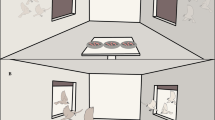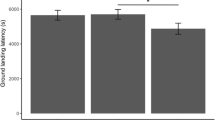Summary
The foraging decisions of animals often reflect a trade-off between the risk of predation and efficient foraging. One way an animal may reduce the risk of predation, and hence exploit a resource patch in relative safety, is by foraging in a group. Solitary ‘pioneer’ sparrows often recruit others to a food source by making chirrup calls in order to establish foraging flocks. This study describes the decisions of house sparrows that arrive at food resources of different risks of predation. Four feeding sites at different distances from a perching site and from an observer were presented to sparrows. When the feeder was adjacent to the perching site and far from the observer, the pioneers chirruped less frequently and were more likely to forage alone than when the feeder was in the other three positions. There were differences in the scanning behaviour of sparrows at these sites, suggesting that they were responding to different risks of predation. Furthermore, the chirrup rates of pioneer sparrows in this study and a previous study were found to be negatively correlated with maximum daily temperature. This is consistent with the hypothesis that energy requirements may affect the flock establishment decisions of sparrows, and that the benefits of foraging in flocks may be greater at lower temperatures.
Similar content being viewed by others
References
Barnard CJ (1980) Flock feeding and time budgets in the house sparrow (Passer domesticus L.). Anim Behav 28:295–309
Barnard CJ (1981) Factors affecting flock size mean and variance in a winter population of house sparrows. Behaviour 74:114–127
Bertram BCR (1978) Living in groups: predators and prey. In: Krebs JR, Davies NB (eds) Behavioural Ecology: an evolutionary approach. Blackwells, Oxford, pp 64–96
Caraco T (1979a) Time budgeting and group size: a theory. Ecology 60:611–617
Caraco T (1979b) Time budgeting and group size: a test of theory. Ecology 60:618–627
Caraco T, Martindale S, Pulliam HR (1980a) Avian time budgets and distance to cover. Auk 97:872–875
Caraco T, Martindale S, Pulliam HR (1980b) Avian flocking in the presence of a predator. Nature 285:400–401
Cerri RD, Fraser DF (1983) Predation risk in foraging minnows: balancing conflicting demands. Am Nat 121:552–561
Dill LM, Fraser AHG (1984) Risk of predation and the feeding behaviour of juvenile coho salmon (Oncorhynchus kisutch). Behav Ecol Sociobiol 16:65–71
Edwards J (1983) Diet shifts in moose due to predator avaidance. Oecologia (Berl) 60:185–189
Elgar MA (1986) House sparrows establish foraging flocks by giving chirrup calls if the resources are divisible. Anim Behav 34:169–174
Elgar MA (1987) Food intake rate and resource availability: flocking decisions in house sparrows. Anim Behav 35 (in press)
Elgar MA, Catterall CP (1981) Flocking and perdator surveillance in house sparrows: test of an hypothesis. Anim Behav 29:868–872
Elgar MA, Burren PJ, Posen M (1984) Vigilance and perception of flock size in foraging house sparrows (Passer domesticus L.). Behaviour 90:215–223
Elgar MA, McKay H, Woon P (1986) Scanning, pecking and alarm flights in house sparrows. Anim Behav 34:1892–1894
Grubb TC, Greenwaid L (1982) Sparrows and a brushpile: foraging responses to different combinations of predation risk and energy cost. Anim Behav 30:637–640
Lendrem DW (1983) Predation risk and vigilance in the blue tit (Parus caeruleus). Behav Ecol Sociobiol 14:9–13
Lima SL, Valone TJ, Caraco T (1985) Foraging-efficiency-predation-risk trade-off in the grey squirrel. Anim Behav 33:155–165
Martindale S (1982) Nest defense and central place foraging: a model and experiment. Behav Ecol Sociobiol 10:85–89
McNamara JM, Houston AI (1986) The common currency for behavioral decisions. Am Nat 127:358–378
Milinski M, Heller R (1978) Influence of a predator on the optimal foraging behaviour of sticklebacks (Gasterosteus aculeatus L.). Nature 275:642–644
Pulliam HR (1973) comparative feeding ecology of a tropical grassland finch (Tiaris olivacea). Ecology 54:284–299
Pulliam HR, Caraco T (1984) Living in groups. In: Krebs JR, Davies NB (eds) Behavioural Ecology: an evolutionary approach, 2nd edn. Blackwells, Oxford, pp 122–147
Pulliam HR, Anderson KA, Misztal A, Moore N (1974) Temperature dependent social behaviour in juncos. Ibis 116:360–364
Schneider KJ (1984) Dominance, predation, and optimal foraging in white throated sparrow flocks. Ecology 65:1820–1827
Sih A (1980) Optimal behaviour: can foragers balance two conflicting demands? Science 210:1041–1043
Snedecor GW, Cockran WG (1967) Statistical Methods. Iowa State University Press, Ames, Iowa
Werner EE, Gilliam JF, Hall DJ, Mittlebach GG (1983) An experimental test of the effects of predation risk on habitat use in fish. Ecology 64:1540–1548
Willis EO (1972) Do birds flock in Hawaii, a land without predators? Calif Birds 3:1–8
Author information
Authors and Affiliations
Rights and permissions
About this article
Cite this article
Elgar, M.A. The establishment of foraging flocks in house sparrows: risk of predation and daily temperature. Behav Ecol Sociobiol 19, 433–438 (1986). https://doi.org/10.1007/BF00300546
Received:
Accepted:
Issue Date:
DOI: https://doi.org/10.1007/BF00300546




